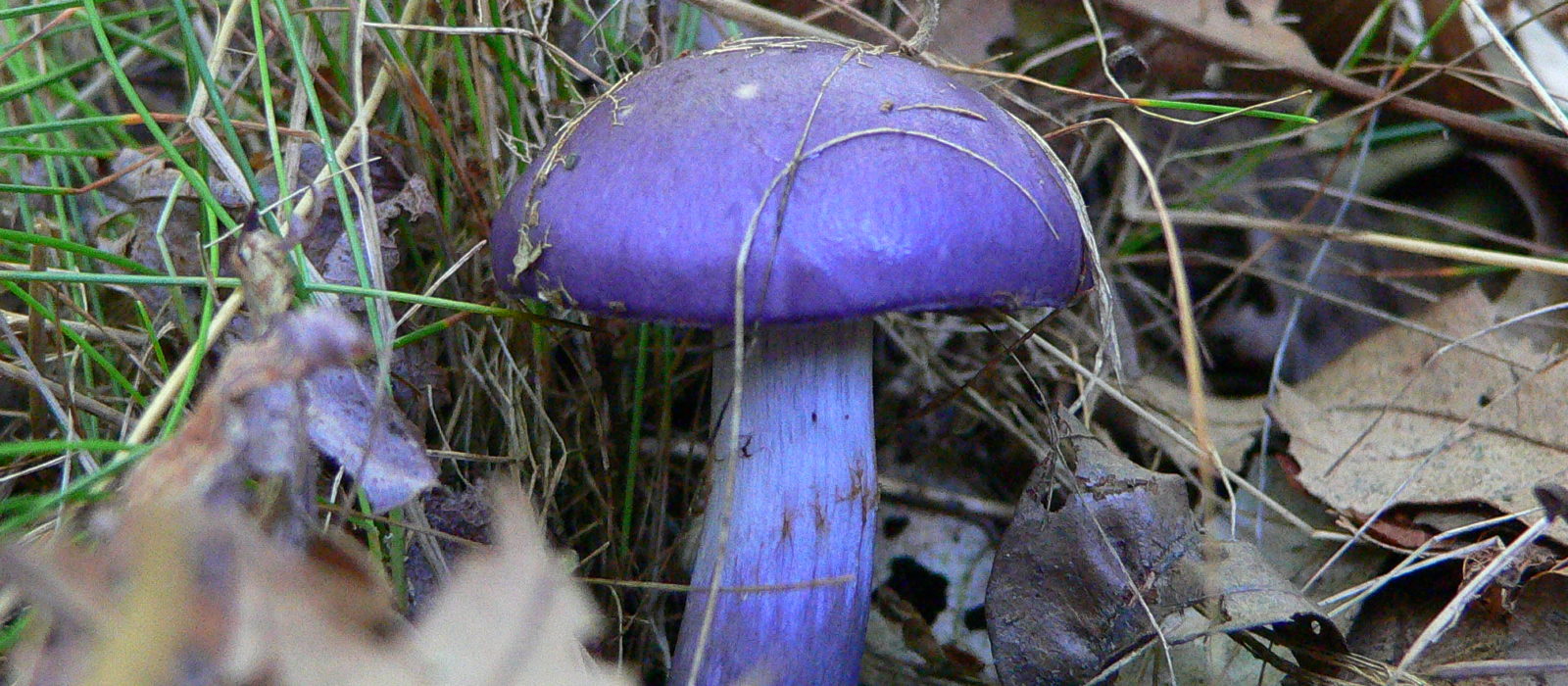Fungi and lichens
This very large Kingdom is estimated to include about 1.5 million species, of which only about 60,000 species have been described scientifically. Nearly all are terrestrial, though there are a few marine species. It is an ancient group known to have existed for at least 450 million years. For the most part, fungi spread through the dispersal of spores, often carried by the wind for great distances. Thus fungi are found nearly world-wide outside of the polar regions and, over time, can easily colonize islands.
Of the five Phyla in the Kingdom, we have representatives of two on Martha’s Vineyard. Phyla are distinguished by the form of their spore-producing cells. There are about 22,250 described species in Phylum Basidiomycota, which includes rusts, smuts, jelly fungi, mushrooms, puffballs, and stinkhorns. About 30,000 species are described in Phylum Ascomycota, which includes yeasts, blue-green molds, morels, truffles, and the fungus component of lichens. Lichens are symbiotic associations between an ascomycetous fungus and an alga. They are included here taxonomically among the Ascomycota. Because of the similarity of appearance of many lichen species, they often must be identified in the laboratory by the use of chemical reagents, a microscope, or both.
Martha’s Vineyard has not been extensively explored for the fungi present in either Phylum, and nearly all the most advanced work has been done very recently by L. Millman. Over 3,000 fungi species exclusive of lichens have been found in New England (W. J. Neill and Boston Mycological Club, pers. comm.). To date, only 149 of those species have been identified on the island out of a total that could easily reach 1,000, leaving a great deal more work to be done. Some species only appear for a very brief period each year and some may not appear for years until soil, moisture and other conditions are just right. The only published field guide for an area near us is Bessette et al. (2001), but it only illustrates a small percentage of the species that occur in the region covered. Two other useful identification guides for our area are McKnight and McKnight (1987) and Lincoff (1997). Other general works on mushroom distribution and taxonomy are Alexopoulos et al. (1996), Hawksworth et al. (1995), Bessette et al. (1997), Arora (1986), Barron (1999), and Phillips (2005). Most of the vernacular or common names given below come from either Bessette et al (2002) or from L. Millman (pers. comm.), but most mushroom species do not have such names. No exploration of Nomans Land Island for fungi other than lichens has yet been done.
Based on the ranges described in Brodo et al. (2001), at least 375 species of lichens could occur on the island, of which 156 species have now been recorded (Kneiper et al. 1995; Kneiper, 2001); 67 of these species have been found on Nomans Land Island National Wildlife Refuge in the Town of Chilmark (Kneiper, 2004). We believe that a higher percentage of the lichen species present on Nomans Land Island has been discovered than has been found on the main island. As would be expected, Nomans Land has fewer species because it has fewer ecological niches. The English lichen names appearing below are from Brodo et al. (2001).
Allan Keith; edited by Matt Pelikan, January 10, 2022
References:
Alexopoulos, C. J., C. W. Mims, and M. Blackwell, 1996. Introductory mycology. 4th edition. Wiley, New York. 868 pp.
Arora, D. 1986. Mushrooms demystified. Ten Speed Press. 958 pp.
Barron, G. 1999. Mushrooms of northeast North America. Lone Pine Press. 335 pp.
Bessette, A. R., A. E. Bessette, and D. Fischer. 1997. Mushrooms of northeastern North
America. Syracuse University Press, Syracuse, NY. 582 pp.
———– and W. J. Neill. 2001. Mushrooms of Cape Cod and the National Seashore. Syracuse University Press, Syracuse, NY. 174 pp.
Brodo, I. M., S. D. Sharnoff and S. Sharnoff. 2001. Lichens of North America. Yale University Press, New Haven. 795 pp.
Hawksworth, D. L., Ainsworth, G. C., and G. R. Bisby. 1995. Ainsworth & Bisby’s dictionary of the fungi, including the lichens. 8th edition. CAB International, Wallingford, Oxon. 616 pp.
Kneiper, E. 2001. Unpublished survey report of lichens at Polly Hill Arboretum, Chappaquiddick, Squibnocket, and Abel’s Hill, Martha’s Vineyard done in October, 2001. 7 pp.
————- 2004. The lichens of Noman’s Land Island National Wildlife Refuge, Chilmark, Dukes County, Massachusetts. Unpublished report prepared for the Polly Hill Arboretum under grant from the Edey Foundation. 17 pp. [On file at Polly Hill Arboretum Library.]
————-, P. May, E. Lay, and L. Berard. 1995. Unpublished report to the Nature Conservancy acting through the Massachusetts Natural Heritage Program under contract #MAHER PS-94-17. 40 pp.
Lincoff, G. 1997. The Audubon guide to North American mushrooms. Knopf Publishing Co. 926 pp.
McKnight, K. and V. McKnight. 1987. The Petersen field guide to mushrooms. Houghton Mifflin, Boston. 429 pp.
Phillips, R. 2005. Mushrooms and other fungi of North America. [reprint of 1991edition]. Firefly Books. 319 pp.
Stephenson, S. L. and H. Stempen. 1994. Myxomycetes: a handbook of slime molds. Timber Press, Portland, OR.
